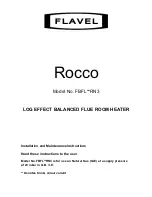
53
PERIODIC MAINTENANCE
PERIODIC MAINTENANCE
Table 14.
Maintenance Schedule
Component
Operation
Interval
Reference
Tank
Drain and Flush
Every 6 Months
See
.
Tank
Lime Scale Removal
(Water Less Than 25 Grains
Hard)
Not Required
N/A
Tank
Lime Scale Removal
(Water Greater Than 25
Grains Hard)
Annually
See
.
Burner Flames
Inspection
Every 3 Months
See
Burner
Inspection/Cleaning
As Needed
Contact qualified agency or profes-
sional.
Moving Parts
Lubrication
Not Required
N/A
Powered Anodes
Inspection/Cleaning
Annually
See
T&P Valve
Test Operation
Semi Annually
See
Temperature-Pressure Relief Valve Test
.
Vent System
Inspection
Annually
See
.
Condensate Neutral-
ization
Inspection
Annually
See manual for the condensate
neutralization kit.
Condensate Col-
lection
Cleaning
Annually
See
.
VENTING SYSTEM INSPECTION
Breathing Hazard - Carbon Monoxide Gas
•
Flue gases may escape if vent pipe is not
connected
•
Be alert for obstructed, sooted, or deteriorated
vent system to avoid serious injury or death.
•
Do not store corrosive chemicals in the
vicinity of the water heater.
•
Chemical corrosion of the flue and vent system
can cause serious injury or death.
•
Analyze the entire vent system to make sure that
condensate will not become trapped in a section
of vent pipe and therfore recuce the open cross
sectional area of the vent.
Breathing carbon monoxide can cause brain damage or
death. Always read and understand instruction manual.
At least once a year examine the vent system. Points of
inspection are as follows:
1.
Check for obstructions and/or deterioration of the intake air and/
or vent piping and the intake air and vent terminations. Replace
immediately where needed.
2.
The debris screens in the intake air and vent terminations should
be cleaned of foreign material and soot.
Note:
Do not reach inside the vent termination when the heater
is in operation.
3.
Check all vent system connections for leakage and repair or
reseal as necessary.
Be sure the vent piping is properly connected to prevent escape
of dangerous flue gasses which could cause deadly asphyxiation.
Obstructions and deteriorated vent systems may present serious
health risk or asphyxiation.
Chemical vapor corrosion of the flue and vent system may occur
if air for combustion contains certain chemical vapors. Spray can
propellants, cleaning solvents, refrigerator and air conditioner
refrigerants, swimming pool chemicals, calcium and sodium chloride,
waxes, bleach and process chemicals are typical compounds which
are potentially corrosive.
If after inspection of the vent system you found sooting or
deterioration, something is wrong. Call the local gas utility to correct
the problem and clean or replace the flue and venting before
resuming operation of the water heater.
ANODE ROD INSPECTION
To insure a long, trouble-free operating life, the water heaters
covered in this manual are factory equipped with one of two types
of anodes: powered and sacrificial. The following sections describe
the inspection appropriate for each type.
Note:
To check which type of anode is installed, refer to the Heater
Status menu of the UIM (user interface module). If the water
heater is equipped with a powered anode rod, this menu will
display the Anode Current, Anode Tank Voltage, and Anode
Drive Voltage statuses. If the Anode Current, Anode Tank
Voltage, and Anode Drive Voltage statuses are not displayed,
the water heater is equipped with sacrificial anode(s). See
(page 10) to locate the UIM and see
POWERED ANODE RODS
The anode rod is of a permanent design (non-sacrificial) and does
not need to be replaced unless damaged. Periodic inspection of the
powered anode rod is required annually.
A “No Water” or “Anode Shorted” fault displayed on the UIM indicates
a potentially damaged anode rod. If the powered anode rod has
been damaged, it should be removed and replaced from the water
heater tank.
Important:
If the damaged powered anode rod has not been
replaced but has been removed permanently, this will
void any warranties.
Note:
Whether re-installing or replacing the powered anode rod,
check for any leaks and immediately correct if found.
To replace the powered anode:
1.
Turn off electrical supply and gas supply to the water heater.
2.
Shut off the water supply and open a nearby hot water faucet to
depressurize the water tank.
3.
Drain approximately 5 gallons of water from tank. See
(page 55) for the procedure. Close drain valve.
4.
Remove the wiring connection on the top of the powered anode
and remove the old powered anode rod.
5.
Use Teflon
®
tape or approved pipe sealant on threads and install
new anode rod.
6.
Turn on water supply and open nearby hot water faucet to purge
air from water system. Check for any leaks and immediately
correct any if found.
7.
Restart the water heater as directed in this manual.
SACRIFICIAL ANODE RODS
Avoid damage.
Property Damage Hazard
Inspection and replacement of anode rod required.
Each water heater contains at least one anode rod, which will slowly
deplete (due to electrolysis) prolonging the life of the water heater
Содержание 300 Series
Страница 66: ...66 NOTES NOTES...
Страница 67: ...67 NOTES NOTES...
Страница 68: ...68 Copyright 2020 All rights reserved...
















































